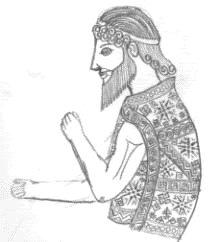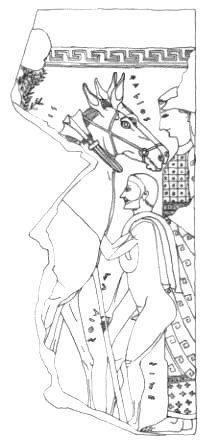 |
Painters of Larger Pots
The painter who inherited Nearchos' style and
became the master of black figure is Lydos[1].
Although he also painted on cups, his style is well established
on larger vessels. Even though the figures on a column krater
in New York (31.11.11), dated to c.550-540, are less detailed
than those of Nearchos, the each figure moves lively and freely
in different movement from each other. The scene on this krater
is Dionysos leading Hephaistos to Olympos accompanied by Satyrs
and Maenades.
Unfortunatelly scattered into many pieces, his
dinos from the Acropolis and now in the National Museum of
Athens (Acr.607) must be his masterwork. Although the vase
is too fragmental to understand the composition, the figures
can be compared with Nearchos'[2]. The scene
depicted on this vase is Gigantomachy, the battle between
deities and giants and the painter added names to the figures.
Of smaller vessels, oinochoe in Berlin (1732)
has an animal frieze on the lower body, while the battle between
Herakles and Ares is depicted on the main panel. Part of Athena
in this scene is drawn with outline technique, which is often
used by his contemporary, the Amasis Painter. The name Lydos
implies he was Lydian and he signed himself as a slave[3].
The Amasis Painter is named after the potter
Amasis who produced vessels for this painter, though it is
often supprsed that they are identical [4].
The name Amasis is not Greek but Hellenized version of a common
Egyptian name[5]. In his style we can find
strong East Greek elements, which reflects on his lively style.
His style can be found on a belly amphora in
Basel (Ka420). The subject is Dionysos and his companies,
which is the most favorite subject in his repertorie. On this
vase, Satyrs are making wine while Maenades drawn with outline
technique attend. He also painted cups and a cup in Boston
(10.651) has the shape "B type", which has continuous
outline from lip to foot and is favoured by red figure painters.
Eyes on the exterior are copied from East Greek cups and the
Amasis Painter arranged the eye as the body of Siren.
A neck amphora in Paris, Cabinet des Medailles
(cab.med.222) is one of his masterpiece. Dionysos and two Maenades
are arranged on the wide surface in lively composition, which
can be rarely found on Lydos' vases. Again the flesh of Maenades
is depicted with outline technique.
Exekias signed both as potter and painter. His
masterpiece is the belly amphora in Vatican, dated to c.540-530
(fig.1,vatican344)[6]. Its detailed representation,
especially the patterns on garments and armours, cannot be
found any other painter's works.

Fig. 1
The composition of Achilleus and Aias playing
chess at Troy is also outstanding. The painter made viewer's
eyes concentrate on the chess board at the centre led by the
heroes' eyes, hands and spears. Also the spears lead our eyes
to the handles. Although the figures are symmetrically arranged,
Exekias differenciate both figures in every details. It is
also noticeable that depth is represented by overlapping spear,
board, legs and mantles.
The belly amphora in Boulogne shows his grandeur
style (boulogne558). The subject on this vase is Aias' suicide. Again the
painter introduced simple composition consisting of Aias,
his shield and helmet and a tree. He chose not the climax
of the hero's suicide, which is chosen by later painters,
but its preparation. Although black figure technique can hardly
represent emotion, we can feel the tension and the hero's
distress. Since Exekias often depicted Aias, some scholars
believe that he is from Salamis, the birth place of this hero[7].
Exekias introduced new technique on the cup
in Munich (munich2044). The shape is so called A type which has a shallow bowl
with plain lip and a splaying foot offset from the bowl. The
tondo has Dionysos lying on his ship surrounded by dolphins.
Exekias filled around the tondo with coral red, though this
technique was rarely followed. Other than these, he also painted
on series of funeral plaques (fig.2).

Fig.2
There are more painters specialized in larger
pots. The Affecter painted characteristic figures with tiny
heads and angular bodies [8]. His colleargue
the Elbows Out painted mannered figures with exaggrated posture.
The Swing Painter chose outstanding scenes [9].
Group E is closely related to earlier works of Exekais and
some vases attributed to this group can be depicted by this
master.
Painters of cups
Painters who preferred cups in this period are
named Little Masters after the miniatuaristic representation
which was already attempted on the Francois Vase [10].
There are two types of cups after the shape and decoration,
though the differene of the shape is slight.
The band cup has a decorative band on the handle
zone while other areas are filled with black. The tondo rarely
has figures. Lip cup has figures at the centre of the lip
and the surfece is reserved except for narrow black bands,
while the handle zone occasionally has potter's or painter's
signature. A figure or two is sometimes decorated within the
tondo.
The Tleson Painter often decorated cups made
by Tleson, son of Nearchos. On the band cup in Munich (SL
462) he painted cockfighting, in which we can find no trace
of Corinthian influence anymore. While the band cup signed
by Neandros in Boston (61.1073) has animal frieze of Corinthianized
style.
More detailed representation can be found on
another band cup in Munich (2243). Although the cup has the
signatures by Archikles and Glaukytes, it is uncertain which
is the painter or potter. On one side has Kalydonian boar
hund, while Theseus fighting against Minotaur on the other
side. It is surprising how the painter drew such small but
detailed figures, more than 10 figures on either side, within
the frieze of about 3cm height. He even added the name to
all the figures.
The lip cup signed by Xenokles and attributed
to the Xenokles Painter in London (B 425) has Zeus and his
brothers flanked by a winged horse. Another lip cup in London
by the Phrynos Painter has the birth of Athena and Herakles
led by Athena to Zeus (londonB424). Sakonides preferred to depict female heads on the lips
with outline technique [11].
Other than these cups, smaller cups so called
Droop cups were also produced [12]. Decoration
scheme is similar to that of band cups, though detailed patterns
are often depicted on the lower body, which recall decoration
on Lakonian cups.
While these painters exploited the potential
of black figure technique, they also reached the limitation
of this technique. It gave the birth of new technique, red
figure, about 530. Black figure technique, however, still
used by lesser painters under strong influence from red figure
painters.
| [1] |
For Lydos,
see, Tiberios, M. A., O Lydos
kai to ergo tou, (1976), Rumpf, A., Sakonides,
(1937), Richter, G. M. A., "Lydos", MMS
4, pp.169-178. |
| [2] |
For the
reconstruction of the dinos, see, Moore,
M. B., "Lydos and the Gigantomachy", AJA
83, pp.79-99. |
| [3] |
For the
signature as slave by Lydos, see, Canciani, F., "Lydos,der
Slave?", AK 21, pp.17-21. |
| [4] |
For Amasis
and the Amasis Painter, see, Beazley, J. D., "Amasea",
JHS 51, pp.257-284, Karouzou, S., The Amasis
painter, (1956), Bothmer, D. v., The Amasis painter
and his world, (1985), True, M. (ed. ), Papers
on the Amasis painter and his world, (1987), Boardman,
J., "The Amasis Painter", JHS 78, pp.1-3,
Bothmer, D. v., "AMASIS,AMASIDOS", JPGMJ
9, pp.1-4, Isler, H. P., "Der Topfer Amasis und der
Amasis-maler", JdI 109. |
| [5] |
For the
relationship between Amasis and Egypt, see, Boardman,
J., "Amasis: The implications of his name",
in: True, M. (ed.), Papers on the Amasis painter and
his world, pp.141-152, (1982). |
| [6] |
For Exekias,
see, Technau, W., Exekias,
(1936), Mommsen, H., Exekais I: Die Grabtafeln,
(1997), Boardman, J., "Exekias", AJA
82, pp.18-24. |
| [7] |
For the
discussion about Exekias and salamis, see, Moore, M. B.,
"Exekias and Telamonian Ajax", AJA 84,
pp.417-434, Shapiro, H. A., "Exekias, Ajax and Salamis:a
further note", AJA 85, pp.173-175. |
| [8] |
For the
Affecter, see, Mommsen, H., Der Affekter, (1975). |
| [9] |
For the
Elbows Out, see, Bothmer, D. v.,
RA 1969, pp.3-15. For the Swing Painter, see, Bohr,
E., Der Schaukelmaler, (1982). |
| [10] |
For the
little masters, see, Beazley, J.
D., "Little Master cups", JHS 52, pp.167-204. |
| [11] |
For Sakonides,
see, Rumpf, A., Sakonides,
(1937). |
| [12] |
For Droop
cups, see, Ure, P. N., "Droop
cups", JHS 52, pp.55-71. |
|
 |